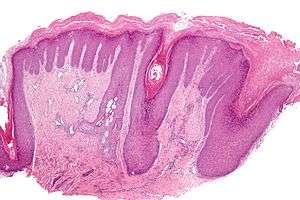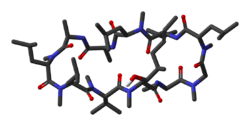Ullrich congenital muscular dystrophy
| Ullrich congenital muscular dystrophy | |
|---|---|
 | |
| Autosomal recessive pattern | |
| Classification and external resources | |
| OMIM | 254090 |
| DiseasesDB | 33679 |
| GeneReviews | |
Ullrich congenital muscular dystrophy is a form of congenital muscular dystrophy.It is associated with variants of type VI collagen, it is commonly associated with muscle weakness and respiratory problems, though cardiac issues are not associated with this type of CMD.[1][2]
Signs/symptoms
The presentation of Ullrich congenital muscular dystrophy in an affected individual is as follows:[3]
- Muscle weakness
- Difficulty walking
- Contractures (neck)
- Joint looseness
Genetics
In terms of the genetics of Ullrich congenital muscular dystrophy,there are mutations in the genes COL6A1, COL6A2, and COL6A3. This sub-type of muscular dystrophy is autosomal recessive in nature.[4][5]
COL6A1 plays an important part in maintaining the human body's integrity of various tissues. Alpha 1 subunit of type VI collagen is the encoded protein.[6]
Diagnosis

In terms of the diagnosis of Ullrich congenital muscular dystrophy upon inspection follicular hyperkeratosis, may be a dermatological indicator,additionally also serum creatine kinase may be mildly above normal.[2] Other exams/methods to ascertain if the individual has Ullrich congenital muscular dystrophy are:
Treatment

Treatment for Ullrich congenital muscular dystrophy can consist of physical therapy and regular stretching. Respiratory support may be needed at some point by the affected individual.[7]
Though cardiac complications are not a concern in this type of CMD, in regards to respiratory issues ventilation via a tracheostomy is a possibility in some cases.[2][8]
Prognosis
The prognosis of this sub-type of MD indicates that the affected individual may eventually have feeding difficulties. Surgery, at some point, might be an option for scoliosis.[7]
Scoliosis which is a sideways curve of the persons vertebrate, is determined by a variety of factors, including the degree (mild or severe), in which case if possible a brace might be used by the individual[9]
Research

In terms of possible research for Ullrich congenital muscular dystrophy one source indicates that cyclosporine A might be of benefit to individuals with this CMD type.[10]
According to a review by Bernardi, et al, cyclosporin A (CsA) used to treat collagen VI muscular dystrophies demonstrates a normalization of mitochondrial reaction to rotenone.[11]
See also
References
- ↑ "Ullrich congenital muscular dystrophy - Conditions - GTR - NCBI". www.ncbi.nlm.nih.gov. Retrieved 2016-05-11.
- 1 2 3 GeneReviews/NCBI/NIH/UW entry on Collagen Type VI-Related Disorders
- ↑ Reference, Genetics Home. "collagen VI-related myopathy". Genetics Home Reference. Retrieved 2016-05-11.
- ↑ RESERVED, INSERM US14 -- ALL RIGHTS. "Orphanet: Congenital muscular dystrophy, Ullrich type". www.orpha.net. Retrieved 2016-05-11.
- ↑ Bönnemann, Carsten G. (2011-01-01). "The collagen VI-related myopathies Ullrich congenital muscular dystrophy and Bethlem myopathy". Handbook of Clinical Neurology. 101: 81–96. doi:10.1016/B978-0-08-045031-5.00005-0. ISSN 0072-9752. PMID 21496625. – via ScienceDirect (Subscription may be required or content may be available in libraries.)
- ↑ "COL6A1 collagen type VI alpha 1 [Homo sapiens (human)] - Gene - NCBI". www.ncbi.nlm.nih.gov. Retrieved 2016-05-11.
- 1 2 "Ullrich congenital muscular dystrophy | Disease | Treatment | Genetic and Rare Diseases Information Center (GARD) – an NCATS Program". rarediseases.info.nih.gov. Retrieved 2016-05-11.
- ↑ "Congenital Muscular Dystrophy Treatment & Management: Medical Care, Surgical Care, Consultations".
- ↑ "Scoliosis: MedlinePlus". www.nlm.nih.gov. Retrieved 2016-05-12.
- ↑ "OMIM Entry - # 254090 - ULLRICH CONGENITAL MUSCULAR DYSTROPHY 1; UCMD1". omim.org. Retrieved 2016-05-12.
- ↑ Bernardi, Paolo; Bonaldo, Paolo (2013-05-01). "Mitochondrial Dysfunction and Defective Autophagy in the Pathogenesis of Collagen VI Muscular Dystrophies". Cold Spring Harbor Perspectives in Biology. 5 (5): a011387. doi:10.1101/cshperspect.a011387. ISSN 1943-0264. PMC 3632061
 . PMID 23580791.
. PMID 23580791.
Further reading
- Ph.D, Evelyn B. Kelly (2013-01-07). Encyclopedia of Human Genetics and Disease [2 volumes]. ABC-CLIO. ISBN 9780313387142.
- Carakushansky, Gerson; Ribeiro, Marcia Gonçalves; Kahn, Evelyn. "Moderately progressive Ullrich congenital muscular dystrophy". Jornal de Pediatria. 88 (1): 93–96. doi:10.2223/JPED.2112. ISSN 0021-7557.
- "National Guideline Clearinghouse | Evidence-based guideline summary: evaluation, diagnosis, and management of congenital muscular dystrophy: report of the Guideline Development Subcommittee of the American Academy of Neurology and the Practice Issues Review Panel of the American Association of Neuromuscular and Electrodiagnostic Medicine.". www.guideline.gov. Retrieved 2016-05-12.
- Hicks, D.; Lampe, A. K.; Laval, S. H.; Allamand, V.; Jimenez-Mallebrera, C.; Walter, M. C.; Muntoni, F.; Quijano-Roy, S.; Richard, P.; Straub, V.; Lochmuller, H.; Bushby, K. M. D. (16 November 2008). "Cyclosporine A treatment for Ullrich congenital muscular dystrophy: a cellular study of mitochondrial dysfunction and its rescue" (PDF). Brain. 132 (1): 147–155. doi:10.1093/brain/awn289. Retrieved 12 May 2016.